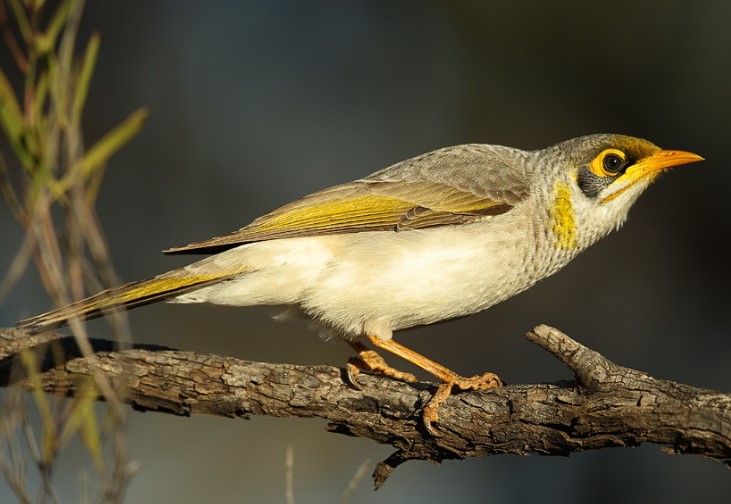Family: The yellow-throated miner (Manorina flavigula) is endemic to Australia and is among the most common of all colonial honeyeaters.
Behavior and Habitats: It is a medium-sized, yellow-billed, and footed honeyeater that lives in tight communal groups and primarily feeds on insects. They come in tight groups of four to six individuals. Besides being the most widespread of them, the yellow-throated is also the most nomadic of them, as it inhabits the open woodlands throughout the inland.
After breeding, some colonies of the mallee and mulga scrubs may remain sedentary throughout the year in better-watered areas. Still, those in the drier mallee and mulga scrubs may wander locally after breeding. A flock of 50 or more birds is then formed after a handful of local communes coalesce into larger flocks of up to a dozen birds. Similarly to all other miners, the yellow-throated miner has a strong limb structure and sharp claws and can hang from trunks and branches for some time in strange, inverted poses.
Unlike the Noisy Miner, Yellow-throated Miners nest in small, close-knit colonies that consist of several individual groups of a pair plus one or two helpers, all nesting in tandem with each other in the same colony. Both males and females care for the young birds. They work together; males may come singly into the nest and feed the nestlings of several females at the same time.
When they leave the nest, the fledglings remain together, fed by the adults. During each feeding, they beg loudly and squeak loudly, a characteristic that all honeyeaters share, but they do not flutter their wings at all. There is some confusion in Australia between the native aggressive miners and the aggressive common mynas, which is probably due to the fact that this is an introduced pest.

Feed: As they forage there, they hop about, poking under bark and gleaning among foliage for insects. They also spend a lot of time on the ground, walking and searching among the litter, dung, and even dead leaves and grass to find beetles, ants, wasps, bees, bugs, weevils, and caterpillars. There have also been instances where fruit and seeds have been picked.
Additionally, nectar may have been plucked from eucalyptus trees and other exotic flowers on occasion. After feeding, playing, and flying in slow flutters and glides, foraging bands will fly several hundred meters from one group of trees to another, feeding, playing, and fluttering through the air as they pass each other slowly. Similarly to other communal miners, they make use of a complex vocabulary of whistled squeaks and soft twittering in order to keep in contact and signal their intentions.
Alternative Names: The bird is also known as Dusky Miner, Black-eared Miner, White-rumped Miner, Bun-Bun, and Mickey.
Size: The size of a yellow-throated miner is about 250–280 mm in length.
Identification: Adults: Both sexes are similar to one another; however, the male is slightly larger than the female. In spite of this, there is a wide range of geographic variations in terms of size and color. From the crown to the mid-back, the hair is medium to dark gray with white flecks at the nape. Forehead washed variably with citrine.
The rump is off-white to mid-grey in color. There is a deep gray-washed citrine color on the wings. The tail is dark gray in color with a broad white tip. The face has a broad black sash through the eyes with or without a white edge; the malar line and the chin are white or dusky in color; there is bare yellow skin at the gape, the sides of the chin, and behind the eye.
From the throat to the undertail, the color is white, with mottling along the breast and with or without yellow wash along the sides of the neck. The eyes are a deep brown color. The bill is yellow in color. There is a yellow-orange color on the feet. Immatures have buff edging on the back and coverts of the wings.

Call: The call of the yellow-throated miner is described as territorial flight teu-teu-teu-teu, which is similar in sound to that of noisy miners. In order to attract ground predators, they use nasal whistles; in order to attract flying predators, they use pure whistles. The sound of soft twittering and whistled squeaking can be heard in groups that are social or feeding.
Song: The yellow-throated miner song consists of a pre-dawn chorus of whistles.
Nests and Breeds: Nesting and breeding occur between July and December, sometimes in response to rain but most often in response to the weather. A nest is a bulky cup with thick walls that often contain wool as well as twigs and grasses and are usually lined with wool, fur, or hair. Cobwebs bind nests to branches, usually in the forks of saplings or near the outer branches of low trees.
Eggs: Normally, the bird lays three or four eggs; each egg is pink to red-buff, with specks or blotches of red or purple-brown, usually at the larger end, and oval in shape, measuring about 26 mm x 18 mm.
Distribution: Yellow-throated miners live in open woodland and copses, such as mulga and mallee, as well as river gums on watercourses throughout the mainland west of the Great Dividing Range and locally on the central east coast of Queensland. Currently, there are three races of mallees: two dark-faced as well as two dark-rumped in the southern and southwestern mallees, previously considered separate species but now hybridizing and intergrading with the white-rumped race. The southeastern ‘Black-eared’ race has now been hybridized out of existence due to the opening up of mallee habitats.
Read More: The Flame Robin (Petroica phoenicea)
